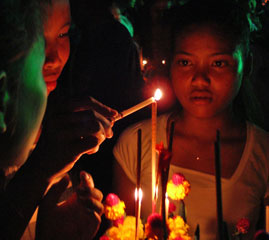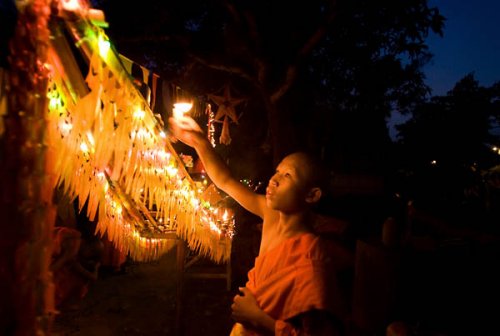Boun Ork Phansa, The Time For Buddhist Festivities
Boun Ork Phansa is the last day of Buddhist Lent. Taking place three lunar months after Khao Phansa, the day is one steeped in tradition and brought alive by celebrations which begin at dawn and continue on way past dusk.
As morning breaks, people across the country flock to temples to present offerings of money and food to resident monks. The morning offering ceremony is quiet and reflective – the calm before the storm of festivities to come.
On the evening of Boun Ork Phansa, candlelight processions are held around temples in celebration of Lay Heua Fai. The river becomes illuminated as people send small boats made of banana leaves, decorated with flowers and carrying candles down the Mekong.
The boats serve as a mark of respect to Buddha and to thank the mother of rivers for providing precious water which sustains life. Some simply believe that the boats symbolise the departure of the previous year’s bad luck to make room for the arrival of good luck. Lao folklore holds, however, that the lighted boats are sent downstream as an act of respect to the Nagas. The Naga is a mythical water serpent believed to reside in the murky depths of the Mekong, but on the night of the 15th day of the 11th month in the Lao lunar calendar, he is said to surface, to shoot bright fireballs into the sky.
Opinion is somewhat divided on whether the Nagas truly exist, but cynicism does not prevent throngs of spectators from lining the banks on both sides of the river to eat, drink and partake in the tradition and frivolities.
In bigger towns processions of lighted boats are floated on the water, while smaller riverside communities will gather for a much more low-key affair. Some light candles in their homes to pay their respects and continue with the tradition that dates back thousands of years.
 Many young couples can be seen embracing the romance of the ceremony, no doubt full of anticipation for what the coming year will bring.
Many young couples can be seen embracing the romance of the ceremony, no doubt full of anticipation for what the coming year will bring.
The Naga fireballs occur in a section of the Mekong stretching over 20km between Pakngum district, about 80km south of Vientiane, and Phonphisai district in Nong Khai province, Thailand.
On the Lao side, some people say they can see the fireballs floating by the ponds and rice fields near their villages. On the Thai side, the fireballs are said to shoot up in a pond locally known as Nong Pra Lay. Crowds of people drive down to the sites, hoping to catch a glimpse of the spectacle.
In Vientiane city centre, the boat racing festival of the following day is the pinnacle of the celebrations. After an early start, rowers and merrymakers alike flock down to the riverbank, singing and banging drums in anticipation of the races. As the boats hit the water at 9am, the riverbank becomes fit to bust with spectators, jostling for the best spot to view the action, armed with copious amounts of beer and all manner of traditional fare which has been plucked en route from the food vendors lining nearby pavements. For those content to watch the proceedings from the cooler confines of their home, the races are broadcast live on television.
published with the permission of Vientiane Times

